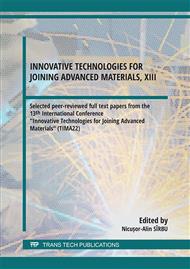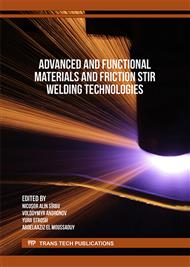[1]
M. A. Wahid, A. N. Siddiquee, Z. A Khan, T. Majeed, N. Sharma, Friction stir welding of AA-5754 in water and air: a comparative study. Materials Research Express, Vol. 6, № 1. (2018), p.19.
DOI: 10.1088/2053-1591/aae6fd
Google Scholar
[2]
L. M. Serio, D. Palumbo, L. A. Filippis, U. Galietti. A. D. Ludovico, Effect of Friction Stir Process Parameters on the Mechanical and Thermal Behavior of 5754-H111 Aluminum Plates. Materials 9, 122 (2016), p.19.
DOI: 10.3390/ma9030122
Google Scholar
[3]
M. Vural, A. Ogur, G. Cam, C. Ozarpa, On the friction stir welding of aluminium alloys EN AW 2024-0 and EN AW 5754-H22, Archives of Materials Science and Engineering 28(1), January (2007), pp.49-54.
DOI: 10.1002/mawe.201700096
Google Scholar
[4]
D. Ren, F. Zeng, Y. Liu, L. Liu, Z. He, Friction Stir Welding of 5754 Aluminum Alloy with Cover Sheet, Materials 12, 1765, (2019), p.10.
DOI: 10.3390/ma12111765
Google Scholar
[5]
M.I. Costa, D. Verdera, C. Leitão, D.M. Rodrigues, Dissimilar friction stir lap welding of AA 5754-H22/AA 6082-T6 aluminium alloys: Influence of material properties and tool geometry on weld strength, Materials and Design 87, (2015), p.721–731.
DOI: 10.1016/j.matdes.2015.08.066
Google Scholar
[6]
A. B. Chehreh, M. Grätzel, J. P. Bergmann, F. Walther, Fatigue Behavior of Conventional and Stationary Shoulder Friction Stir Welded EN AW-5754 Aluminum Alloy Using Load Increase Method, Metals 10, 1510. (2020), p.11.
DOI: 10.3390/met10111510
Google Scholar
[7]
D. Gospodinov, N. Ferdinandov, M. Ilieva, R. Radev, Mechanical properties of Aluminium Alloy 1050 welded by Friction Stir Welding, Proceedings of University of Ruse, vol. 60, book 2.1 (2021), pp.22-28.
Google Scholar
[8]
N. Botila, R. Gojocaru, V. Verbitchi, C. Ciuca, Friction stir processing in multiple passes of cast aluminium alloy EN AW 5083, Welding & Material Testing №3 (2019), pp.3-7.
Google Scholar
[9]
N. Botila, R. Gojocaru, V. Verbitchi, C. Ciuca, Friction stir processing in multiple passes of cast aluminum alloy EN AW 4047 (AlSi12), Welding & Material Testing. №2 (2019), pp.13-17.
Google Scholar
[10]
P. Sadeesh, M.Venkatesh, V. Rajkumar, P. Avinash, N. Arivazhagan, K. Devendranath, S. Narayanan, Studies on friction stir welding of AA 2024 and AA 6061 dissimilar metals. Procedia Engineering 75(2014), p.145 – 149.
DOI: 10.1016/j.proeng.2013.11.031
Google Scholar
[11]
P. Prashant, J. Sanjay, L. Shree, A study of process parameters of Friction Stir Welded AA 6061 Aluminum Alloy, International Journal of Innovative Research in Science, Engineering and Technology, Vol. 2, Issue 6, (2013), pp.2304-2309.
Google Scholar
[12]
A. B. Chehreh , M. Grätzel, J. P. Bergmann, F. Walther, Effect of Corrosion and Surface Finishing on Fatigue Behavior of Friction Stir Welded EN AW-5754 Aluminum Alloy Using Various Tool Configurations, Materials 13, 3121(2020), p.20.
DOI: 10.3390/ma13143121
Google Scholar
[13]
L. A. C. Filippis, L. M. Serio, D. Palumbo, R. Finis, U. Galietti, Optimization and Characterization of the Friction Stir Welded Sheets of AA 5754-H111: Monitoring of the Quality of Joints with Thermographic Techniques, Materials 10, 1165 (2017), p.18.
DOI: 10.3390/ma10101165
Google Scholar
[14]
M. Paidar, S. Mehrez, O.O. Ojo, V. Mohanavel, B. Babaei, M. Ravichandran, Modified friction stir clinching of AA6061-T6/AA5754-O joint: Effect of tool rotational speed and solution heat treatment on mechanical, microstructure, and fracture behaviors, Materials Characterization, Vol. 173, (2021).
DOI: 10.1016/j.matchar.2021.110962
Google Scholar
[15]
X. Liu, C.S Wu, Elimination of tunnel defect in ultrasonic vibration enhanced friction stir welding. Materials & Design, Vol. 90, (2015), pp.350-358.
DOI: 10.1016/j.matdes.2015.10.131
Google Scholar
[16]
H. Zhang et al, Growth mechanism and motion trajectory of lazy "S" in friction stir welding joint of 6082-T6 aluminum alloy. SN Appl. Sci. 3, 278 (2021).
DOI: 10.1007/s42452-021-04198-z
Google Scholar



